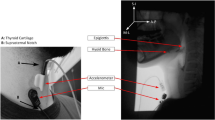Abstract.
The aim of this study was to investigate the response characteristics of the Computerized Laryngeal Analyzer (CLA) and the validity of the noninvasive CLA method to detect swallowing-induced laryngeal elevation correctly. Two healthy adults and two experimental models were used in the study. The CLA technique identified all swallowing events but was unable to discriminate between swallowing and other movements of the tongue or the neck. The computer program produced a derivated response to a square wave signal. Stepwise bending increments of the sensor displayed a linear amplitude response. The degree of laryngeal elevation could not be estimated with the CLA technique, and it was not possible to draw any reliable conclusions from the recordings as to whether the larynx was moving upward or downward.
Similar content being viewed by others
Author information
Authors and Affiliations
Rights and permissions
About this article
Cite this article
Danbolt, C., Hult, P., Grahn, L. et al. Validation and Characterization of the Computerized Laryngeal Analyzer (CLA) Technique. Dysphagia 14, 191–195 (1999). https://doi.org/10.1007/PL00009605
Issue Date:
DOI: https://doi.org/10.1007/PL00009605




